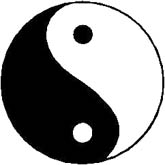The word Mandala is derived from the Sanskrit word meaning "circle."  Throughout the East and Middle East, drawings in the mandala form stand for unity, harmony and wholeness.
Throughout the East and Middle East, drawings in the mandala form stand for unity, harmony and wholeness.
Carl Jung considered the mandala a universal expression of the human psyche regardless of national origin. He discovered in his work helping people integrate their rational and intuitive selves that mandala drawing was also common to the Western mind even though its most conscious expression was found in Eastern cultures. By reflecting on the mandalas we create, we can see more clearly and deeply into our intuitive nature.
The Tao mandala represents the flowing harmony of dark and light. Most people have probably seen this simple yet powerful symbol. A mandala with the simplicity and power of the yin-yang circle of the ebb and flow of experience captures profound insight into the human condition. In the beginning, our drawings will be more elaborate like the examples in this section. However over time they may acquire the sense of simplicity found in the Tao symbol or in another mandala that appears in the author section.
Most of the examples in the Gallery are abstract. But some of the drawings have concrete images that represent tangible objects in experience. Also notice that some have geometric shapes other than curved spaces. We should draw whatever combination of images captures the experience of the moment whether they are abstract circular and/or abstract geometric and/or concrete literal.
Drawing Mandalas
Using small, medium and large felt tip markers with at least six different colors, we spontaneously compose images to fill in the circle with whatever strokes the hands feel the need to express. This practice does not require "artistic" skill. Each person draws at the level of their ability without making judgements about the "quality" of the work. The drawing may extend beyond the boundary to fill the page similar to the examples in this section.
We provide a template for mandala drawing in Acrobat format. View and/or save the file to use as a drawing outline. (Please Note: In order to view and print Acrobat PDF files, you must have the freely distributed Adobe Reader installed on your computer.)
- Acrobat Mandala Template (2K Acrobat pdf)
Observations and Comments
It is common to experience initial frustrations and challenges at the beginning of the drawing process which then give way to gradual discoveries and valuable insights. We have provided a summary of comments so that we can learn from the experiences of others.
Vulnerablility and Strength
While drawing, some may encounter others who will not understand the unusual drawings. These people might react the way we would initially. Only they will not have the opportunity to experience the drawing discovery process. Try not to let their sometimes negative comments get in the way of the work.
A previous student has provided us with her own personal story of what happened when she first begin to draw mandalas. It is important that we listen to her story and learn from her experiences. The delicate process of discovering The Intuitive Self should to be nurtured by all.